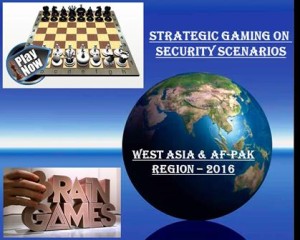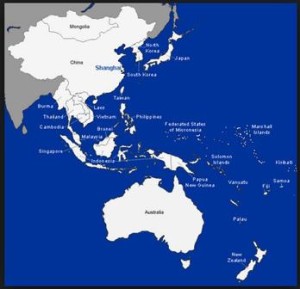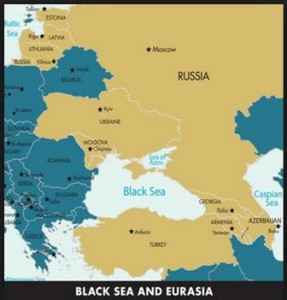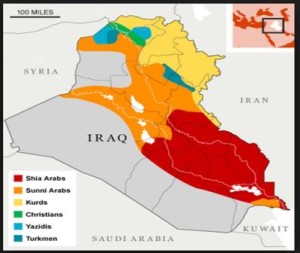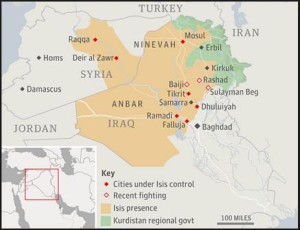CONDUCTED
BY
ON
16 SEP 2014
A brainstroming session on ‘Security Scenario In West Asia & Af-Pak Region’ was organised at the USI of India, New Delhi on 16 Sep 2014. Strategic Game Setting was prepared by core team of USI and played with the eminent experts.
Core team consisting of :
(a) Lt Gen P K Singh,PVSM, AVSM (Retd), Director, USI
(b) Maj Gen B K Sharma,AVSM, SM**(Retd), Head of Centre for Strategic Studies & Simulation, USI
(c) Maj Gen P K Goswami, VSM (Retd), Distinguished Fellow, USI
Following eminent scholars participated inbrainstroming session :
(a) Lt Gen P C Katoch, PVSM, UYSM, AVSM, SC (Retd). An accomplished security analyst and former Defence Attaché to Japan.
(b) Lt Gen H S Lidder, PVSM, UYSM, YSM, VSM (Retd). Former Chief of Integrated Staff, HQ IDS and Defence Attaché to USA.
(c) Ambassador R S Kalha, IFS (Retd). Former Secretary in the MEA and Ambassador of India to Indonesia and Iraq.
(d) Ambassador Nalin Surie, IFS (Retd). Former Secretary (West) and Ambassador of India to China and High Commissioner to UK.
(e) Ambassador Jayant Prasad, IFS (Retd). Former Special Secretary in the MEA and Ambassador of India to Algeria, Afghanistan and Nepal.
(f) Ambassador Sanjay Singh, IFS (Retd). Former Secretary (East) and Ambassador of India to Iran.
(g) Ambassador Ajai Malhotra, IFS (Retd). Former Ambassador of India to the Russia.
(h) Ambassador Arundhati Ghose, IFS (Retd). Former Ambassador of India to Republic of Korea, Egypt, and Permanent Representative to the UN Offices in Geneva.
(j) Ambassador Meera Shankar, IFS (Retd). Former Ambassador of India to USA and Germany.
An Overview
1. The brainstorming was premised on the festering geopolitical crises in West Asia and Af-Pak region and its wider ramifications for regional peace and security. Considering the volatility, complexity and level of uncertainty of the geostrategic environment, the setting was restricted to the short term, up to 2016. The setting provided a broad overview of the geopolitical and strategic trends in the Indo-Pacific, West Asia, Eurasia and Af-Pak regions and their impact on the emerging world order and balance of power. The central theme of the narrative devolved around strategic nuances of ethno-regional / sectarian conflicts in West Asia, escalation of jihadi violence in the Af-Pak region and the strained Indo-Pak and Sino-Indian relations.With that as a geo-strategic backdrop, the scenarios dilated on the specifics of threatsposed by ISIS in West Asia, escalation of violence in Syria and Palestine and their wider impact on regional geopolitics and security. The scenario covered the role of regional and extra regional players in the ensuing conflicts. Concurrent with West Asia crisis, the scenario also delved into the vitiated security situation in the Af-Pak region, its internal and external linkages and growing tensions among India – Pakistan – China. The setting sought to highlight the hybrid nature of asymmetric threats, its trans-national character and the role of state and non-state actors (NSAs), including extra regional players in conflict escalation and resolution. The setting provided participants a broad strategic framework to carry out in-depth analyses of the dynamics of conflicts in West Asia and Af-Pak region against a global backdrop. The scenario descriptions were designed to enable participants to do ‘role playing’ as heads of government of major players, prepare comprehensive assessments, discuss dilemmas, examine intention – capability co-relation and formulate comprehensive strategic response to achieve a desired outcome in keeping with respective national interests.
Aim
2. The aim of the brainstorming session was to analyse dynamics of conflicts in West Asia, Af-Pak region and Indo-Pak-Sino imbroglio; their impact on regional and national security and formulation of comprehensive response strategy in keeping with national interests.
Scope
3. The scope of the brainstorming session was:-
(a) Understanding dynamics of the emerging world order and its impact on the balance of power.
(b) Analysis of ethno-regional and sectarian conflicts in West Asia, their causes and effects.
(c) Analysis of the causes and effects of jihadi violence in Af-Pak region and Indian sub-continent.
(d) Dynamics of Pak – China strategic nexus and its implications for India.
(e) Role of extra regional players in the ensuing conflicts in West Asia and the Af-Pak region.
(f) Formulation of comprehensive assessments of emerging scenarios and evaluation of strategic options.
(g) Recommended strategic response for achieving the desired end state.
Highlights of Global Geo-Political Scan
4. Geopolitics of Asia – Pacific Region (APR). It covered strategic and economic importance of Asia – Pacific Region, prevailing contested sovereignty between regional players over island territories, control over energy resources in contested territories and dominance of SLOCs. In brief, Asia Pivot/Rebalancing strategy of US, Counter Intervention strategy of China, East Asia Pivot of Russia, Look East policy of India and Swan Strategy of ASEAN were discussed. Interplay of these strategies portend conflict of strategic objectives of competing nations, leading to emerging alliances, strategic competition/ cooperation and security challenges in the region.
5. Eurasia. It coveredstrategic and geopolitical developments in the region, in back drop of ongoing competition between the West (US & EU) and Russia, for expanding and domination of the region. It highlighted turmoil in the former Soviet Union states, in the backdrop of continued power struggle in the region and expanding influence of the Western world. Events leading to strategic rivalry between the US and its NATO allies on the one side and a resurgent Russia on the other, in the context of prevailing crisis in Ukraine were also discussed.
6. West Asia. It covered geo-strategic and economic importance of the region, prevailing geopolitical shifts and internecine ethno – religious strife that have shaped and reshaped its political and security landscape. It highlightedpopular uprising against autocratic regimes and monarchies, cyclical crises in Palestinian, Libya and Yemen, and prevailing serious ethnic conflict in Iraq & Syria; and reshaping of the socio-political, economic and security landscapes of the region. Regional scan emphasized the prevailing complications and contradictions due to divergent interests of regional and extra regional players, glaring divide between regional players and competition to dominate the region; and deduced its implications on regional security scenarios. In brief, developments in Iraq, Syria, Turkey, Lebanon, Iran, Saudi Arabia, Jordan, Egypt and Israel were discussed, and its impact on regional stability and implications for India were highlighted.
7. South Asia. It highlighted diversity of region in terms of religion, ethnicity, language and political ideology. The South Asian landmass is connected to the IOR and its continental – maritime confluence imparts increased strategic importance, thus making it an important theatre for great power brinkmanship. Due to strategic importance of IOR, there is presence of regional and extra regional powers in the region to serve their strategic objectives in South Asia, Asia – Pacific and Middle East. This has further added to security challenges in the region. The region is also mired in internal security problems, unsettled territorial disputes, terrorism and nuclear arms race which place it under heightened security risks. The China has emerged as a key player in the region and draws political, diplomatic, economic and military concessions from the smaller regional countries, and fueled strategic competition. The present environment in the region is in ferment and suffers from elusive peace and fragile security. Thus, South Asia has emerged as one of the pivotal regions of Asia.
8. Af-Pak Region. It highlighted the prevailing instability in the region as it is the epicenter of global terrorism. This situation is worsened by ethnic divisions and the power play of regional and external players. It emphasized that post-US drawdown; socio-political stability in Afghanistan will remain fragile and prone to exploitation by jihadists and Pakistan. Pakistan also remains politically unstable, and this has further affected its continued fragile economic and internal security situation. In this prevailing uncertain security scenario, jihadists have further strengthened their hold over the Af-Pak region in general; and Waziristan including FATA, NWFP and adjoining eastern Afghanistan and Baluchistan in particular. Internal and external security and environmental dynamics of the region were also discussed.
Outline Scenario – 2016
West Asia
- This scenarios were painted in the time frame of 2016, highlighting developments in the region due to the interplay of strategic interests of regional and extra regional players. Following players were discussed:
(a) ISIS: Degraded but not defeated
(b) Iraq: Salvaging National Identity
(c) Syria: A Confused Melee
(d) Iran: The Covert Operator
(e) Saudi Arabia: The Beleaguered Kingdom
(f) Israel, Palestine, Lebanon: A Wider Conflagration
(g) The United States: Re-Entering the Quagmire
(h) Russia: A More Assertive Presence
(j) Turkey: ‘Neo-Ottomanism’ in Tatters
(k) Europe: Reluctance to Intervene
(l) China: A Study in Reticence
(k) Pakistan, Afghanistan: Wary of the ISIS Threat
(l) India: Walking the Tightrope
10. Triggers. Events in the region, which will set off important and sudden changes in regional and global geopolitics, were elucidated as triggers. These were:
(a) Kidnapping of foreign nationals in Iran and Syria by ISIS.
(b) Beheading of kidnapped US diplomatic staff in Syria by ISIS.
(c) In retaliation, US air offensive against ISIS in northern Syria and shooting down of a US fighter jet by the Syrian military.
(d) Russia and Iran joined the ensuing clash between the US and Assad regime and the situation escalated into a major standoff between the world’s big powers in the region.
(e) Suicide attacks on Shia religious places at Karbala and Najaf, killing of a number of Shias including a top Iranian cleric. This sparks off large-scale sectarian violence and killings in Iraq.
(f) Israeli air offensives into Syria in retaliation of rocket attacks on Golan Heights from the Syrian territory.
(g) Assassination of senior Syrian political leader, triggering widespread violence and instability in the country and the region.
Af-Pak Region
11. In the projected time frame of 2016, this scenario highlighted socio-political instability and the worsening security scenario in region. The region continues to be an epicenter of international terrorism and a major source of regional instability. Sectarian violence in Pakistan and Afghanistan against Shia community has strained their respective relations with Iran. Emergence of new alignment between Jihadi networks is posing a united and most formidable threat to the region. Vexed nature of contentious issues between India – Pakistan – China further complicate security dilemmas and these remain a potential source of state-to-state conflict. Following players were discussed:
(a) Afghanistan. It emphasised elusiveness of a viable political reconciliation in Afghanistan, despite formation of National Unity Government with power sharing between the two main political entities. The ANSF remains weak and maintains a semblance of security in Kandhar and other important towns. Ascendant Taliban continue to pose a major threat to state security and continues to enlarge its control. ‘State of Forces Agreement’ was signed and US and other countries are partially fulfilling their obligations of financial aid. US adopted a ‘Hub and Spoke’ deployment pattern, with the Bagram base at Kabul as hub. Jihadi groups have kept militancy on the boil in southern and eastern parts of Afghanistan, and declared Nizam-e-Mustafa by imposing Sharia Law in the territory under their control. Interplay of primary objectives of US, Russia, China, Pakistan and India in Afghanistan were highlighted.
(b) Pakistan. It highlighted the Army’s influence in conducting state affairs, particularly in the domains of security and foreign policy, in the wake of the political crisis of 2014. Internal security scenario in the country remains fragile with fissiparous tendencies in Waziristan, Balochistan and the Northern Areas. TTP has not only reclaimed its influence in North Waziristan but commenced targeting civil and military installations within Pakistan. Security scenario in Baluchistan has also worsened and the Baluch Liberation Army has increased attacks against Pakistan military and Chinese workers in the area. Iran-Pakistan relations have worsened due to sporadic attacks by Jundallah on Iranian border towns. Chinese presence in the Northern Areas of POK has created unrest among the local Shia and Ismaili population. Pakistan openly blamed India and US for supporting separatist movements in Baluchistan and Northern areas. China has also enhanced military aid to Pakistan and its clandestine help to maintain Pakistan’s asymmetric edge in nuclear deterrence. China has conducted joint exercises with Pakistan Navy in Bay of Bengal and Arabian Sea; and with Army in Northern Areas of POK under FCNA. Indo-Pak relations continue to be in a logjam. Its policy of using jihadis as a strategic weapon against India continues, and with internal situation in Pakistan further deteriorating, cross border attacks increased and ceasefire agreement virtually stands abrogated.
(c) China. It highlighted deteriorating internal situation due to public protests against corruption, media control, environmental degradation and displacement of people, in the wake of government policies directed at construction of new SEZs, townships and industries. Deteriorating internal security situation in Xinjiang, Inner Mongolia and Tibet, and alienation of the population due to use of force to quell the unrest were discussed in detail. Situation resulted in mobalisation of a military area command to Tibet. Chinese counsellor in the Indian capital was attacked and seriously injured. All these developments were interpreted by China as the handiwork of India and the US to project their country in poor light. China warned India not to permit its territory for anti-China activities. PLA mobilized two Group Armies from Chengdu and Lanzhou Military regions for Trans-Regional Support Operations (TRSO) Exercise, in Tibetan Plateau. The exercise coincided with a joint logistics exercise and airborne drills by PLAA.
(d) India.
(i) Indian government successfully implemented domestic reforms to usher in comprehensive national development, pursue proactive diplomacy and develop credible deterrence. Government is fully focused on modernization of armed forces, infrastructure development in border areas, encouraging domestic defence industry, creation of world class infrastructure and ensuring food, house and education for all. Despite political stability, India continues to face internal security challenges due to continued Proxy War in J&K, simmering insurgency in North East and Maoist-affected states.
(ii) The trajectory of India-China relations is showing an upward trend, albeit amid the shadow of dispute over the shared border. Both are working together to steer regional cooperation and advance their efforts to build the BCIM (Bangladesh, China, India and Myanmar) economic corridor. Despite Border Defence Agreement and other confidence building measures, Depsang-like incidents continue. China is livid over India deepening its strategic ties with Vietnam and Japan, while it is expanding engagements with India’s neighbours to disrupt the existing balance of power in the region in its favour. Thus, the two sides overtly talk sweet with each, but covertly continue to engage in a game of one-upmanship on the geostrategic chessboard. Indian initiated Project Mausam, aims at restoring India’s ancient maritime routes and cultural links in the region. This initiative has considerably improved India’s overall image in South Asia and IOR Rim States. A revitalized Indo-US relationship is focused on increasing bilateral trade and investment by removing barriers. The US is assisting India to strengthen its strategic capabilities for a potential role in IOR and Asian Region. India is effectively balancing its engagement with US and China, and with Russia further building on the “Special and Privileged Strategic Partnership”.
12. Triggers. Events in the region, which will set off important and sudden changes in regional and global geopolitics, were elucidated as triggers. These were:
(a) In Afghanistan, rocket attacks on Indian Embassy at Kabul on 15 August 2016, and the killing of five Indians in a sensational suicide attack in Herat. Terrorists also launched rocket attacks on Indian consulate building in Jalalabad, while a flag hoisting ceremony was in progress. All intelligence agencies are indicating the involvement of ISI.
(b) A car bomb attack on the Phiroze Jeejeebhoy Towers in Mumbai on 28 August 2016, which left 87 dead and more than 275 injured many of them serious. This was a direct attack on the economy of the country.
(c) The same day, a suicide attack at Ragunath Temple in Jammu took place. Three terrorists were killed and identified as Pakistani nationals. Five pilgrims including one constable died and 17 were injured. There was immediate condemnation and rage swept across the country, prompting a unanimous demand for strong action against Pakistan.
(d) On 12 Sep 2016, a Chinese counsellor was seriously injured in an attack. Delhi Police intercepted two cars from which militants had fired and in the ensuing firefight all five occupants were killed. Unconfirmed reports say all five were young and had Mongoloid features. The incident has further widened mistrust between the two countries.
(e) On 16 Sep 2016, simultaneous blasts at Dwarka, Rajiv Chowk and Noida metro stations rocked Delhi. Red alert has been sounded in all metropolitan cities and security enhanced at important installations and public places.
13. During first week of Sep 2016, India mobilized limited number of troops (as laid down in Border Peace and Tranquility Agreement) for the annual routine Operation Alert rehearsals on the Chinese border. As departure from the past, the IAF’s Operation Alert too coincides with ground forces. During this period Indian Navy was conducting joint maneuvers in the Bay of Bengal. There was unusual movement of PLA troops opposite Kameng, RALP, Sikkim and Ladakh. Insistence of Chinese patrols’ to use certain routes for patrolling via tracks on the Indian side is leading to tension at the border. They are also objecting to the location of some boundary markers and bunkers and have asked Indian troops to dismantle these structures. Indian troops, however, have resolutely prevented Chinese troops from altering the status quo. During this period, Indian Army’s surveillance and communication detachments reported erratic functioning of the systems. One of the crucial surveillance satellites too was malfunctioning.
14. Meeting of India’s Cabinet Committee on Security (CCS) is in progress at Prime Minister’s Office, to review the situation and decide further course of action.
Requirement
15. All stakeholders (Iraq, Syria, Iran, Afghanistan, Pakistan, China, Russia, United States and India) were asked to give their assessment, options and strategy to deal with these scenarios. Requirements were:
(a) Assessment of the ongoing crises in the internal and external security of the country.
(b) Assessment of crises in the West Asia and Af-Pak regions and how are these likely to impact the county’s strategic interests?
(c) Visualised role of extra regional players in the West Asia and Af-Pak crises.
(d) SWOT analysis of state capacity vis-à-vis perceived threats and challenges.
(e) Strategy to deal with ongoing internal and external security scenarios and uphold the country’s strategic interests in the changing world order.
(f) Role of UN in conflict prevention/resolution, humanitarian assistance and peace building in West Asia and Af-Pak region; and options to defuse tensions between India-China-Pakistan.
Response
16. Iraq
(a) Focal point of Iraq’s strategy was based on social re-integration by political, security and economic means. It evaluated three strategic options – No outside troops, deployment of additional (outside) troops and de-facto trifurcation of Iraq.
(b) Iraq opted to choke financial support to ISIS and contain it by strengthening of National Guard and Sunni Tribes, as well as deployment of outside troops. It also planned to win hearts and minds of Sunni population by initiating effective CBMs.
(c) However, the following critical uncertainties remain and may change the outcome:
(i) Outside Support – Aerial attacks or combination of aerial attacks and foot on ground.
(ii) Trajectory of future US-Iran and Saudi Arabia-Iran relations.
(iii) Support of Iraq’s Sunni population and its integration Into Security Apparatus.
17. Syria
(a) Syria’s strategic choice was based on defeating ISIS and other opposition groups, followed by a political reconciliation process.
(c) However, the following critical uncertainties remain and may change the outcome:
(i) Support of Anti-Assad Opposition Groups by the West and Gulf countries.
(ii) Aerial attacks on ISIS or combination of aerial attacks with boots on the ground.
(ii) Trajectory of future US-Iran and Saudi Arabia-Iran relations.
18. Iran
(a) In Iraq, it maintains strong influence over new government, provides military aid and limited deployment of troops to degrade ISIS.
(b) In Syria, the survival of the Assad regime at all cost with unflinching and full-fledged support, also supported by Russia and China. It offers resistance to any adventurism by US.
(c) However, the following critical uncertainties remain and may change the outcome:
(i) Support of Anti-Assad Opposition Groups by the West and Gulf countries.
(ii) Success / failure of US efforts to defeat ISIS.
(ii) Breakthrough in US-Iran and Saudi Arabia-Iran relations.
19. Afghanistan. It has opted to address following issues to stabilise situation:
(a) Afghan-led and Afghan-owned reconciliation and reconstruction process.
(b) Economy growth, good governance, education, skill development and employment generation.
(c) Continued engagement of regional and extra-regional players for peace and stability.
(d) However, the following critical uncertainties remain and may change the outcome:
(i) Political reconciliation and stability of unity government.
(ii) Void created by US troop withdrawal, Taliban resurgence and capability of ANSF.
(ii) The role played by Pakistan.
20. Pakistan It adopted following strategy:
(a) Use Islam as a binding force to attain leadership of the Islamic world and act as a moderator with the West. Continue to exploit geostrategic location for GWOT. Leverage Afghanistan / Taliban for Strategic Depth.
(b) Exploit relations with USA & China to marginalize India.
(c) Exploit religious faultlines within India, keep the Kashmir-issue alive and divert Jehadis towards India. Thwart India’s offensive designs through nuclear deterrence and the support of China.
(d) Ensure internal stability by strengthening Governance/ Federal Structure.
(e) However following critical uncertainties remain and may change the outcome:
(i) Survival of democracy vis a vis influence of Army.
(ii) Control over Jihadi groups.
(iii) Economic survivability.
21. China It adopted following strategy:
(a) Address income inequalities and urbanisation through reforms. Control internal security situation in Xingjian and Tibet by promoting religious tolerance and integration of Uighurs & Tibetans in mainstream and power sharing arrangements. Check influence of Taliban and ISIS in Xingjian.
(b) Exploit sustained economic growth to ensure dominant role in global economy. Leverage infrastructural investments in South and South East Asian countries for national interests.
(c) Achieve energy security through spread of risks and improved land and maritime connectivity to energy sources.
(d) Continued military modernization to increase conventional and asymmetric reach to deter adversaries.
(e) In West Asia; exploit opportunity to increase influence in region. Support Iran in to dominate the region, Iraq in its re-construction & restoration of normalcy, and Syria in legitimacy of Assad regime. Support regional forces to defeat ISIS & anti Assad forces.
(f) Pakistan needs to be nurtured, as leverage against India. Increase military assistance to Pakistan Military.
(g) Resolve boundary dispute with India on own terms.
(h) However following critical uncertainties remain and may change the outcome:
(i) Internal security situation in general and control of situation in Xingjian and Tibet in particular.
(ii) Internal security situation and stability in Pakistan and Afghanistan.
(iii) Sustained economic growth.
(iv) US – China and China – India relations
22. Russia It adopted following strategy:
(a) Support stability in Afghanistan, no military involvement and infrastructural development only if paid for.
(b) Provide military support to Iran, Iraq and Syria, support international efforts to defeat ISIS and ensure Assad regime survivability.
(c) Expansionist design of West to Eastern Ukraine to be defeated.
23. United States It adopted following strategy:
(a) Lead international efforts to defeat ISIS by launching air attacks. Encourage regional forces to employ boots on the ground against ISIS. Support Iraqi and Kurdish forces in terms of intelligence, military aid and logistic; without getting directly involved.
(b) Restrain Iran going nuclear, and continue to have influence over Saudi Arabia and Israel.
(c) Saber retelling to bring down Assad regime, without making any efforts towards it.
(d) Enhance capability of ANSF in Afghanistan, and engage Russia and China in institution building and stability in the region.
(e) De-escalate Indo-China and Indo-Pak standoff, and avoid conflict.
24. India It adopted following strategy:
(a) In West Asia, remain ambivalent on crisis in Iraq and Syria, but support all efforts to defeat ISIS. Ensure safety and security of diaspora in West Asia. Mediate US-Iran talk for early finalization to safe guard national interests. Be prepared to support militarily under UN banner.
(b) In Afghanistan, continue soft power approach for capacity building in field of security, judiciary, education, health and agriculture.
(c) With China, build strong economic leverages and efforts to resolve boundary issue. Continue military modernization to deter any adventurous activities by China and Pakistan.
(d) With Pakistan, strong response to any adventurous activities
(e) However following critical uncertainties remain and may change the outcome:
(i) Deteriorating internal security situation in Pakistan and Afghanistan, and control of TTP and Taliban respectively.
(ii) India-US, India-Japan and India-China relations and its trajectory in economic field.
(iii) India’s economic growth and internal stability.
(FOR FULL DETAILS OF STRATEGIC SCENARIOS CONTACT USI OF INDIA)


